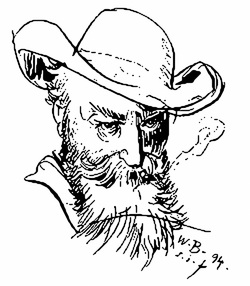
Wilhelm Busch
(1832 -1908, Germany) The German nineteenth-century artist Wilhelm Busch is regarded as one of the founders of the modern comic medium. He became interested in art after seeing the work of the Dutch and Flemish painters Frans Hals and Paul Rubens. After completing a polytechnical studies in Hanover and an education in lithography in Dusseldorf, Busch settled in Munich and started drawing caricatures for the paper Fliegende Blätter in 1859, and from 1871 also in Münchener Bilderbogen. Initially influenced by the Swiss artist Rodolphe Töpffer, Busch’s art style eventually developed into a more fluid one, while his storytelling became more satirical. In 1865, he drew his “pictoral stories” with the characters ‘Max und Moritz’, two unscrupulous and sadistic boys. Although the characters appeared in only one story (which consisted of 7 episodes), ‘Max und Moritz’ became Germany’s best known comics characters, were translated in over 30 languages and inspired various artists in the decades that followed.
Most notably, the American artist Rudolph Dirks based his ‘Katzenjammer Kids’ on the two mischeavous boys. In addition, Busch conceived works like ‘Drei Bilderbogen’ (1860-62), ‘Bilderpossen’ (1864), ‘Die Kühnen Müllerstöchter’ (1868), ‘Pater Filuzius’ (1872), ‘Die Fromme Helene’ (1872), ‘Dideldum’ (1874), ‘Flipps der Affe’ (1879), ‘Mahler Klecksel’ (1884), ‘Von mir über mich’ (1879), ‘Eduards Traum’ (1891), ‘Der Schmetterling’ (1895), ‘Zu Guter Letzt’ (1904), ‘Hernach’ (1908) and the posthumous released ‘Schein und Sein’.
(www.lambiek.net)
Der Eispeter
Katze und Maus